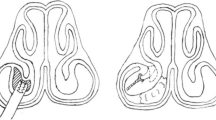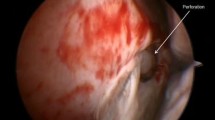Abstract
Purpose
The techniques to be performed for bullous middle turbinates are well-defined and widely accepted in the literature. However, in the case of solid middle turbinate hypertrophy, information on surgical techniques that take into account function and sense of smell is very limited in the literature. The aim of this study was to compare the airway patency and olfaction results of patients diagnosed with solid middle turbinate hypertrophy, who underwent subtotal (transverse) resection or medial flap turbinoplasty of the middle turbinates.
Methods
Thirty-five adult patients who were diagnosed with solid middle turbinate hypertrophy were divided into two groups, namely medial flap middle turbinoplasty (study group = 17) and transverse resection to the middle turbinate (control group = 18). Acoustic rhinometry, anterior rhinomanometry, peak nasal inspiratory flowmeter test, odor identification test, and n-butanol threshold measurements were performed before and 3 months after the surgery. In addition, preoperative and postoperative nasal obstruction and olfactory senses of the patients were evaluated with visual analog scale and nasal obstruction symptom evaluation scale.
Results
Visual analog scores for olfaction were significantly higher in the study group compared to the control group. In odor identification test, a significant improvement was observed in the study group, while a decrease was observed in the control group. While there was a decrease in the n-butanol thresholds values in the study group, there was an increase in the control group.
Conclusions
Medial mucosal flap technique is an effective and functional turbinoplasty technique that can be used in solid hypertrophy of the middle turbinate, which offers advantages in terms of enhanced airway healing and olfactory results.





Similar content being viewed by others
References
Okuyucu Ş, Akoǧlu E, Daǧli AŞ (2008) Concha bullosa pyocele. Eur Arch Oto-Rhino-Laryngol. https://doi.org/10.1007/s00405-007-0448-0
Zinreich S, Albayram S, Benson M, Oliverio P (2003) “The ostiomeatal complex and functional endoscopic surgery,” in Head and neck imaging. P Som Ed 4th ed. St Louis: Mosby, pp. 149–173
Salihoglu M, Cekin E, Altundag A, Cesmeci E (2014) Examination versus subjective nasal obstruction in the evaluation of the nasal septal deviation. Rhinol J. https://doi.org/10.4193/rhin13.057
Cain WS, Gent JF, Goodspeed R, Leonard G (1988) Evaluation of olfactory dysfunction in the connecticut chemosensory clinical research center. Laryngoscope. https://doi.org/10.1288/00005537-198801000-00017
Friedman WH, Katsantonis GP, Rosenblum BN, Cooper MH, Slavin R (1986) Sphenoethmoidectomy: the case for ethmoid marsupialization. Laryngoscope. https://doi.org/10.1288/00005537-198605000-00001
Friedman M, Caldarelli DD, Venkatesan TK, Pandit R, Lee Y (1996) Endoscopic sinus surgery with partial middle turbinate resection: Effects on olfaction. Laryngoscope. https://doi.org/10.1097/00005537-199608000-00012
Marchioni D et al (2008) Middle turbinate preservation versus middle turbinate resection in endoscopic surgical treatment of nasal polyposis. Acta Otolaryngol. https://doi.org/10.1080/00016480701827541
Zhu M, Yan Y, Gong H, Wu Y, Tan G (2020) Two different therapies for the middle turbinate during endoscopic sinus surgery for chronic rhinosinusitis. Eur Arch Oto-Rhino-Laryngol. https://doi.org/10.1007/s00405-020-06184-4
Ciprandi G, Mora F, Cassano M, Gallina AM, Mora R (2009) Visual analog scale (VAS) and nasal obstruction in persistent allergic rhinitis. Otolaryngol Head Neck Surg. https://doi.org/10.1016/j.otohns.2009.06.083
Friedman M, Landsberg R, Tanyeri H (2000) Middle turbinate medialization and preservation in endoscopic sinus surgery. Otolaryngol Head Neck Surg. https://doi.org/10.1067/mhn.2000.105921
Patel ZM, Delgaudio JM (2016) Olfaction following endoscopic skull base surgery. Curr Opin Otolaryngol Head Neck Surg. https://doi.org/10.1097/MOO.0000000000000216
de Rezende PF, Ctenas B, Weber R, Saldiva PH, Voegels RL (2013) Olfactory neuroepithelium in the superior and middle turbinates: Which is the optimal biopsy site. Int Arch Otorhinolaryngol. https://doi.org/10.7162/S1809-97772013000200004
Soriano RM, Arturo Solares C, Pradilla G, DelGaudio JM (2021) Endoscopic study of the distribution of olfactory filaments: a cadaveric study. Am J Rhinol Allergy 35(2):226–233. https://doi.org/10.1177/1945892420948784
Rawson NE, Gomez G, Cowart B, Restrepo D (1998) The use of olfactory receptor neurons (ORNs) from biopsies to study changes in aging and neurodegenerative diseases. Ann N Y Acad Sci. https://doi.org/10.1111/j.1749-6632.1998.tb10648.x
Thompson CF, Kern RC, Conley DB (2015) Olfaction in endoscopic sinus and skull base surgery. Otolaryngol Clin North America. https://doi.org/10.1016/j.otc.2015.05.007
Egbert H. Huizing, John AM, de Groot (2017) Functional Reconstructive Nasal Surgery. https://doi.org/10.1055/b-0035-121531
Mabry RL (1991) Inferior turbinoplasty. Oper Techn Otolaryngol Head Neck Surg. https://doi.org/10.1016/S1043-1810(10)80053-3
Al-Reefy H, Hopkins C (2013) Endoscopic assisted modified turbinoplasty with mucosal flap. J Laryngol Otol. https://doi.org/10.1017/S0022215113000728
Naraghi M, Amirzargar B, Meysamie A (2012) Quality of life comparison in common rhinologic surgeries. Aller Rhinol. https://doi.org/10.2500/ar.2012.3.0020
Barham HP, Knisely A, Harvey RJ, Sacks R (2015) How i do it: Medial flap inferior turbinoplasty with illustration and video. Am J Rhinol Aller 29(4):314–315. https://doi.org/10.2500/ajra.2015.29.4168
Kumral TL et al (2015) Comparison of two partial middle turbinectomy techniques for the treatment of a concha bullosa. Laryngoscope. https://doi.org/10.1002/lary.25065
Bermüller C, Kirsche H, Rettinger G, Riechelmann H (2008) Diagnostic accuracy of peak nasal inspiratory flow and rhinomanometry in functional rhinosurgery. Laryngoscope. https://doi.org/10.1097/MLG.0b013e318161e56b
Author information
Authors and Affiliations
Contributions
AO: conceptualization, methodology, writing—original draft preparation. OO: conceptualization, project administration, writing—reviewing and editing. AOS: visualization, resources, investigation. RD: software, supervision, formal analysis. ES: supervision, visualization, data curation.
Corresponding author
Ethics declarations
Conflict of interest
No conflicts of interest, including any financial support.
Additional information
Publisher's Note
Springer Nature remains neutral with regard to jurisdictional claims in published maps and institutional affiliations.
Supplementary Information
Below is the link to the electronic supplementary material.
Supplementary file1 (MP4 53827 KB) Video 1: medial flap middle turbinoplasty surgical technique
Rights and permissions
Springer Nature or its licensor (e.g. a society or other partner) holds exclusive rights to this article under a publishing agreement with the author(s) or other rightsholder(s); author self-archiving of the accepted manuscript version of this article is solely governed by the terms of such publishing agreement and applicable law.
About this article
Cite this article
Ozdem, A., Ozturan, O., Sutcu, A.O. et al. Medial flap middle turbinoplasty for solid middle turbinate hypertrophy: improving airway, speeding healing and preserving olfaction. Eur Arch Otorhinolaryngol 281, 805–816 (2024). https://doi.org/10.1007/s00405-023-08264-7
Received:
Accepted:
Published:
Issue Date:
DOI: https://doi.org/10.1007/s00405-023-08264-7




